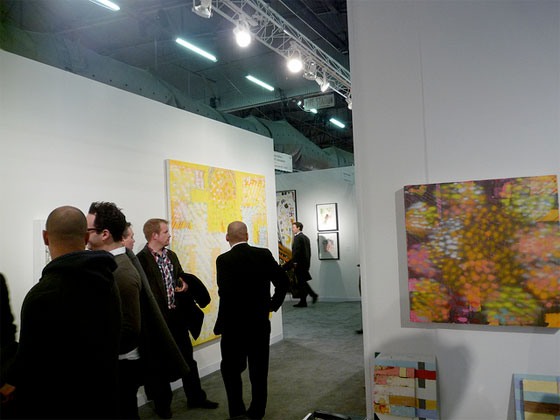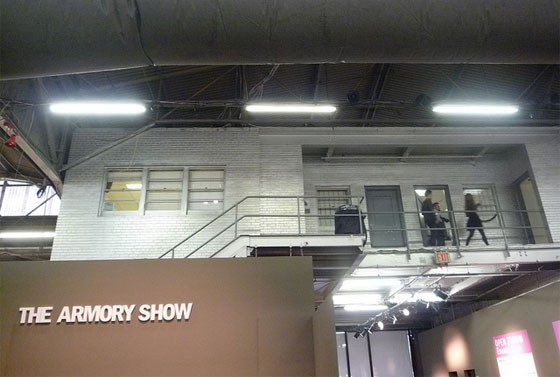What effect does 25 fewer exhibitors have on The Armory Fair? Gone is the barnyard of sculpted animals exhibitors shipped in last year, so that’s one positive outcome, though there’s still surprisingly little space to walk around. The fair also managed to retain its rinky-dink lighting and staircase of doom; if The Armory lost venders because it failed to deliver premium exhibition space, it will lose still more next year.
For the most part though, sales volume determines gallery participation in these shows. “We decided that we'd find success other places.” Julia Joern, a director at David Zwirner, told me last week. This year, Zwirner chose only to participate in the ADAA Art Show. “The last couple of years at the Armory have not been very successful for us.” Joern explained, adding, “And that's not just us.”
Michael Gillespie, co-owner of Foxy Production, a gallery not participating in any fairs this week, like Joern described a need to conserve resources. “…Like a lot of galleries we do maybe three a year, so we pick and choose,” he told me, “This year, [the Armory] just wasn’t a priority. We’re already in New York and I think there is saturation in New York anyway.” Foxy will be taking their wares to Art Cologne in April and Vista in Basel this spring.

Alice Neel's "Nancy" (1980) sold for $850,000 at David Zwirner's ADAA booth
Zwirner will be participating in a number of international fairs as well, citing their lack of satellite galleries in other countries as part of the rationale. Neither gallerist mentioned the large cost of international shipping: presumably this is made up for in sales, but that may be the largest indication yet that New York is not the hub it once was.
Not everyone has the same take. When I told Phil Grauer of CANADA yesterday that I was not, in general, a big fan of the Armory fair, he rolled his eyes and called me “one of those”. Grauer, who sold a large number of works in his booth yesterday, lamented that other dealers in his neighborhood had declined to participate. “Who are these people?” he cried, “You think you can afford to do nothing? Pick a fair God damn it.” Grauer has previously described the location of his gallery on the edge of Chinatown and the Lower East Side as challenging: collectors do not visit on a whim, so the fairs are seen as essential, and an important part of building the New York fine art marketplace.
Notably, Grauer’s point wasn’t that those galleries had to participate in the Armory itself (though I’d guess that would be his preference), only that they partake in the fair week. I’m not sure I like any of the other fairs all that much, but maybe there’s some good that can come from not having one mothership. That exhibitors are more distributed and a greater variety and character to all the fairs exists is one such positive outcome.

Cordy Ryman and Keltie Ferris at Horton and DCKT
As for Armory sales, there seemed to be plenty of those yesterday, a positive change from last year’s fair. Horton/DCKT have sold nearly their entire booth of Cordy Ryman sculptures and Keltie Ferris paintings; Rhizome.org, a non-profit displaying the work of Seth Price, Harm Van Dorpel and others had made many sales; CANADA has done very well with a booth filled with Michael Williams, Katherine Bernhardt, Xylor Jane, et al. The Modern section appears to be moving a little slower – I fielded a few tepid complaints – but in general the Armory fair is off to a good start.



Comments on this entry are closed.